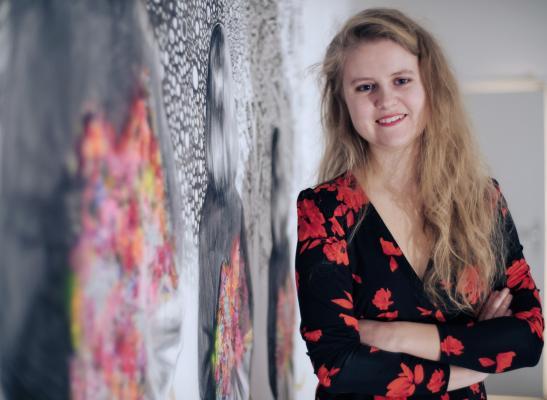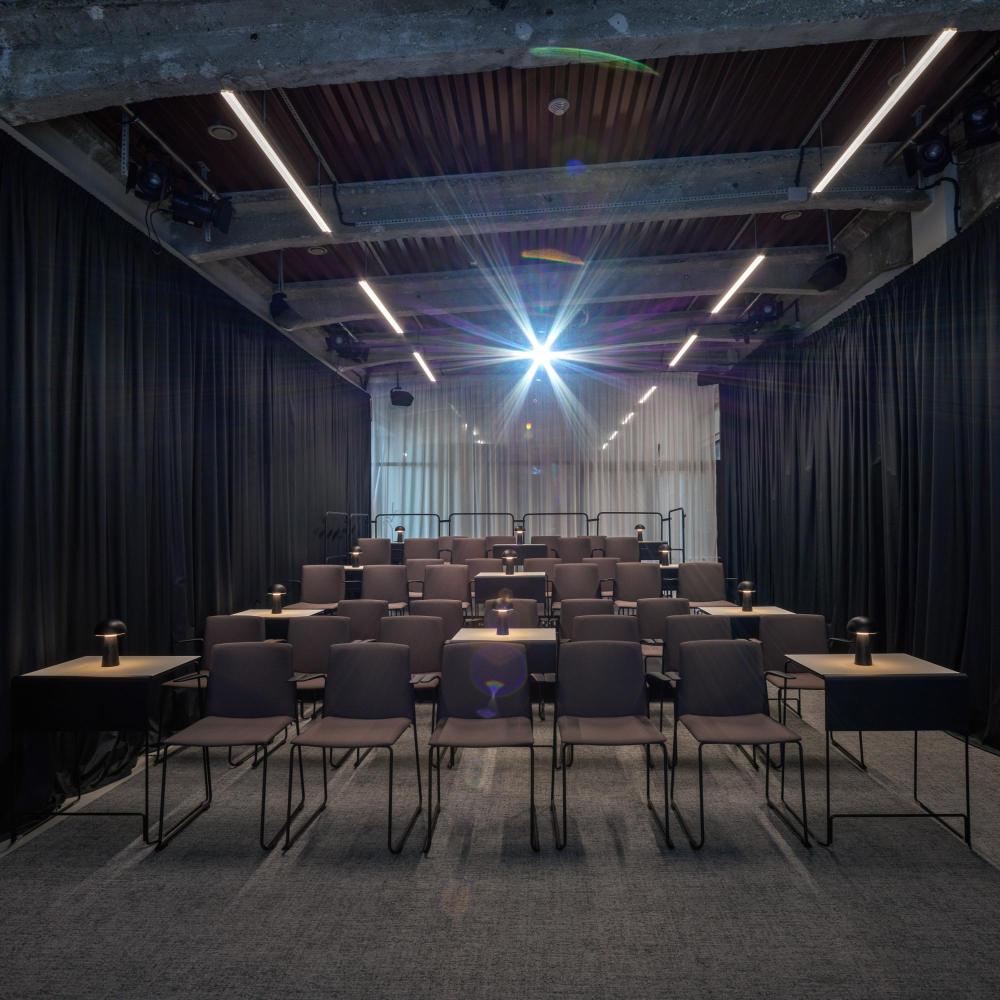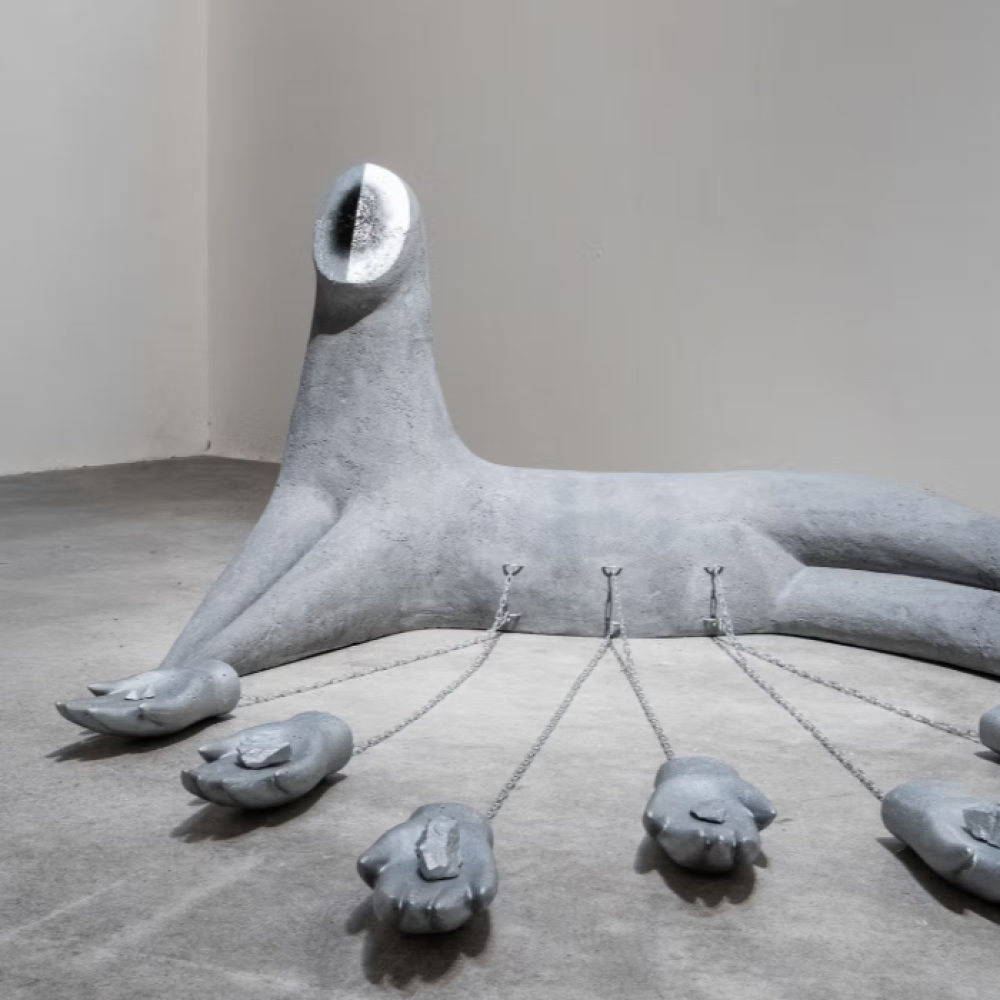
Karolína Netolická (*1993) is an artist belonging to the youngest generation of the Czech art scene and especially the figurative drawing scene. In 2013-2016 she graduated from the Higher Vocational School of Arts and Crafts and subsequently studied in Jiří Petrboek's drawing studio at the Academy of Fine Arts. In 2022 she was awarded the Critics' Prize for Young Painting, yet she considers herself a draughtswoman. Her typical medium has become dry pastel drawing on large format canvases, which aim to immerse the viewer. The relationship between man and nature has become the theme of her work. In her paintings she often layers figurative compositions and merges animal, most often bird, motifs. In this way, she captures the complex reality where man comes from nature but gradually becomes more and more detached from it through his behaviour. The scenery of the forest in the artist's work depicts a lost home, which draws attention precisely to man's lost relationship with nature as he wanders in it.
In 2022 you won the Critics' Prize for Young Painting. What differences do you notice in your current work two years after winning it?
As time has passed, my work has slowly transformed, mainly in terms of content. I used to be heavily inspired by literature with a socio-ecological focus, which I compared to my everyday life and also to the societal events around me. My works were more rationalised and with more appeal to the viewer. Through them, I turned outward. Nowadays, on the other hand, I try to relate more to my own inner self. I work with feelings and emotions, I try for a greater degree of inwardness. In the past I often emphasized the dialogue between man and nature, but today I focus more on the dialogue between two human beings. During the period when I was awarded the Critics' Prize for Young Painting, I was exclusively devoted to the technique of dry pastel, but in recent months I have been experimenting a lot with techniques. Besides pastel, I also paint with acrylic and ink, or create small objects or sculptures from ceramics.
Dry pastel on large format canvas has become your typical medium. Why this particular technique and format?
I came to the dry pastel technique at the end of my third year at the Academy of Fine Arts. Until then, I was constantly drawing with a micro pencil various interiors, architecture and then human figures in down jackets set in night scenery. It was with these drawings of human figures dressed in down jackets that my interest in the dry pastel technique began. I was looking for a way to begin to enlarge these small black and white micro pencil figure compositions while still sticking to the medium of drawing. Dry pastel suited me best because it allowed me to not only draw large formats, but also to touch the canvas, which for me was a kind of creative enrichment with a haptic dimension. Another advantage of pastel is definitely its colourfulness, which I also lacked in my micropencil paintings.
In your paintings, one colour usually dominates along with the darkened atmosphere. Do you also work with the symbolism of colours?
I don't usually work with the symbolism of colours. However, in my paintings there is often a black colour representing darkness. It creates a background or a certain horizon in which something can be shown. I see it as a possibility from which light can be born, so I don't see it as something dark.
Your works personally remind me of photographs taken at night with a flash. Could that mean some kind of shocking capture? Are you aiming for this aesthetic intentionally, or is it some kind of signature of yours that arises unintentionally and evolves spontaneously?
Yes, it is a certain focus on a scene in the dark. This is where the observer's gaze should fall first. The light atmosphere of the flash is in the picture for the sake of greater dramatization and underlining of the scene in question. The place on which the light is focused is also intended to evoke a sense of greater vividness or a certain pulsation of energy in the observer.
Through the large canvases we are brought into the environment of the forest. Your work responds to the relationship between man and nature, do you yourself maintain a connection with nature in any way?
I try to maintain some kind of quiet detached dialogue with nature, but I think that's unfortunately almost impossible in this hectic age of noise. I often try to do this in retrospect when working in the studio. I visit certain places repeatedly, taking photographs of them, which serve as souvenir guides for me in the creation of a painting. Because when I draw those places afterwards, I feel as if I have re-visited them through this process of making them present, and they then become my home for a while.
In an interview you said that the scenery of the forest depicts a lost home and the white masks blindness to the risks of the present. Do the black or coloured balloons that we regularly see in my paintings have a similar symbolic value?
The balloons in my paintings have a slightly different role each time, depending on the context in which I place them. In one of the paintings, for example, they are heavy weights, which is especially the case with black balloons. In another, they symbolize mirrors in which human figures are looking narcissistically. Sometimes they even represent the internal organs of a dead animal. But perhaps most often they represent elements of today's plastic world, which, in my opinion, has no fixed shape or form. I liken the smoothed, shiny balloons to the human face devoid of the wrinkles of today's advertisements, showing a fear of a certain finality, which I outline through the contrast between the shiny smooth surfaces of the balloons that resist finality and the rotting wood of the trees and the decaying leaves on the ground that succumb to finality.
Motifs such as white masks, birds, reindeer, or the antlers themselves recur in your work. Are these constant expressive markers for you, or do you think of other motifs to represent a new era and respond to other risks of the present?
Yes, these motifs appear frequently in my paintings. Animals in my canvases usually play the proxy role of humans. Often, for this reason, my compositions can also appear as fables. On the other hand, I often compare humans to animals, most often to birds, for example in the series Bird Perception, because the two worlds - human and non-human - are inextricably intertwined.
In 2023 you created objects that resonate in some way with your work, including ceramic statuettes. How did you get into this, and how do you evaluate the creation of spatial objects in contrast to the flat ones?
I created them as a kind of installation test, trying to somehow relate to the space and also to transcend the one-dimensionality of the pictorial surface. Among other things, I was trying to get rid of a certain "artifice", so I started to work with existing things around us - for example, down jackets, scarves, rope. From these almost ready-made objects, I then moved on to ceramics at the end of 2023. My paintings often feature simplified, emaciated, headless human torsos. I had a strong urge to try to materialize these bodies more, to let them literally emerge from the paintings. I was looking for a suitable material from which to create them, and ceramic clay seemed the most suitable. I started attending a ceramic workshop. I really enjoyed the whole process of making the torsos out of clay. It almost felt like a kind of birth of living beings, because I see clay as an incredibly physical and living material because it comes from the body of the earth, which I find fascinating.
For the last two months you've been creating in residency at the Telegraph. How has it been working in a different, foreign environment?
I've had a very good time creating at the Telegraph. I felt more focused on the work here, in the context of a greater ritualisation of the day. I find the concept of a residential studio in a gallery very interesting and inspiring. I think the change of environment has benefited me in many ways. The atmosphere of Olomouc has made a strong impression on me, which I hope will be reflected in my paintings that were made during the residency.







